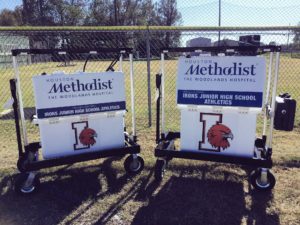Podcast: Play in new window | Download
Today on the podcast Robbie Jenkins from Rapid Reboot talks all things compression therapy in our Compression Roundtable.

What is Rapid Reboot?
Rapid Reboot is a company that specializes in dynamic compression technology that gives you more value for your money.
Robbie and the team at Rapid Reboot felt like there was a unique opportunity to add more to the market of compression therapy. They worked to offer more applications and educate on the many opportunities compression therapy has to benefit our athletes.
What benefits does compression therapy offer?
Most often people think of compression therapy in terms of recovery. Robbie explains that there are many more uses for dynamic compression. Compression can be beneficial to fluid replacement, lymphatic drainage, injury prevention, and pre-workout, pre-game.
How do you educate on the treatment of the lymphatic system since it is a delicate system that doesn’t require a great deal of pressure?
The lymphatic system is unlike other systems in the body in that it doesn’t pump. Evidence doesn’t support using tight as possible to treat it. Robbie recommends that you use well below 100mmHG of pressure if there is a lymphatic issue. However, for healthy individuals that don’t have lymphatic issues you can have 200-300mmHG of pressure combined with sped-up cycle times.
Are there contraindications for the use of dynamic compression therapy?
Yes. DVT, blood clots, as well as post-cancer patients, are contraindications to utilizing compression therapy. DVT is a different scenario as compression therapy is contraindicated if a DVT is present, however, compression therapy has been shown to prevent DVT’s. Surgeons often prescribe compression therapy immediately post-op to prevent the formation of them.
Robbie reminds us that Rapid Reboot is FDA approved and regulated for over the counter use.
What research is available or what is the best practice for the use of compression therapy?
Physicians that Rapid Reboot has spoken to highlight how dynamic compression can help with venous return and how important that is to the cyclical nature of our vascular system.
Robbie finds that with the fluid gathering that tends to happen in our lower extremities due to gravity that the Lower Extremity boots are most beneficial to the entire body, though he loves the hip attachment, as well as probably most beneficial to athletes as all utilize the lower body.
What is one thing Robbie wants AT’s to know regarding dynamic compression therapy?
Don’t put it into one box. Dynamic compression therapy has many benefits, can be used multiple times per day and is safe to use for as long as you want. Pre/post workout and games, prevention as well as post-injury, tight muscles or DOMS are many of the uses for this therapy.
Watch the live stream:
Previous Compression Roundtable conversations
Recovery Pump with Brian Carberry
Call to Action
Instagram us with your favorite uses of compression products @SportsMedicineBroadcast
Jeremy Jackson – Host of The Sports Medicine Broadcast
John Ciecko – jciecko@bloomfield.org
Alisha M Pennington – alisha@theatvantage.com
Mike McKenney – m.mckenney@northeastern.edu
Mike Hopper – Mike.Hopper@bishoplynch.org
Clint Sanders – clint@dragonflyathletics.com
These people LOVE Athletic Trainers and help support the podcast:
Frio Hydration – Superior Hydration products.
Donate and get some swag (like Patreon but for the school)
HOIST – No matter your reason for dehydration DRINK HOIST
MedBridge Education – Use “TheSMB” to save some, be entered in a drawing for a second year free, and support the podcast.
Marc Pro – Use “THESMB” to recover better.
Frio Hydration – Superior Hydration products.
Donate and get some swag (like Patreon but for the school)
HOIST – No matter your reason for dehydration DRINK HOIST
MedBridge Education – Use “TheSMB” to save some, be entered in a drawing for a second year free, and support the podcast.
Marc Pro – Use “THESMB” to recover better.







